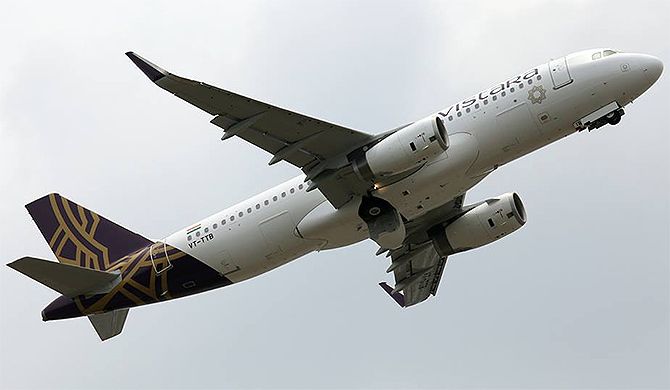We started with no historic data, so we fine-tuned along the way.

Vistara is ready to take off its training wheels and take off in the Indian market, after completing a year of operations.
The airline's new strategy officer, Sanjiv Kapoor, in a free-wheeling chat with Malini Bhupta talks about the flight path he intends to chart.
Excerpts:
What are the top three things on your agenda as chief strategy officer?
As the person in charge of strategy, network, branding and pricing, I want Vistara to be more visible and its pedigree, which is Tatas and Singapore Airlines, to be known to people.
Year one was the year of setting up and so we wanted to learn to walk before we ran. Now as we are settling down, our goal is to ramp up.
We will be increasing frequencies and adding new routes.
By the end of the summer, we expect to have double the number of daily flights we have today.
Vistara's seating configuration was tweaked recently. Did you overestimate the market for premium economy and business class seats?
My previous answer still holds true.
We started with no historic data, so we fine-tuned along the way.
The three-class configuration has been re-calibrated.
We truly believe there is a demand for premium seats.
Consumers are beginning to understand the difference between economy and premium economy a lot more, which comes with more exclusivity, benefits and leg room. We need to focus on communicating this a lot more.
All around the world, when companies started cutting back on travel after the financial crisis, a lot more people were flying economy.
But, these consumers wanted a better option that would not cost as much as a business-class ticket.
This is what has led to the emergence of premium economy segment.
Will your configuration remain the same even when you fly smaller cities?
A lot of small businesses in the smaller cities have a demand for premium economy.
As we expand, if there is a need to focus on smaller cities and we need to look at different configurations targeted at less business-class-oriented cities, we will look at a different configuration where it makes sense.
Airlines across the world do it. British Airways, for instance, has five or six different configurations on their Boeing 747s, depending on which market they are flying.
What non-metro sectors would interest you?
There is great opportunity in non-metro markets.
The Route Dispersal Guidelines categorises metro-to metro routes and some big cities such as Category I route.
Remote regions such as Jammu & Kashmir and Andamans as Category II.
All other cities are classified as Category III, which are non-remote and non-metro.
The requirement for capacity deployment in Category III is 50 per cent of the capacity on Category I, however, if you see how airlines are deploying capacity, it is almost double.
There are smaller cities in India, which are very attractive to fly and gradually we would tap those markets.
Which markets will Vistara look at to grow -- including the metros where capacity is soaked up?
At the moment, the most choked is Mumbai-Delhi, but we'll increase our total flights to 10 between these cities as of now.
Metro to metro markets are not easy and you can make money only if you have multiple flights a day as two flights a day do not make the equation viable.
We will look at the other metro-to-metro routes that are not choked and grow in these.
These routes, too, will get choked in five years due to infrastructure constraints.
Hence, we are considering connecting to more routes from these metros, which we will announce in due course.
Both the Centre and state governments are pushing to attract air traffic to smaller cities. What would Vistara look for to fly to small towns?
We look at what is being offered and do the math.
We would like to see the cost reduction through lower fuel taxes or landing charges and revenue guarantees before deciding.
Image: A Vistara aircraft. Photograph: Kind courtesy, Facebook











